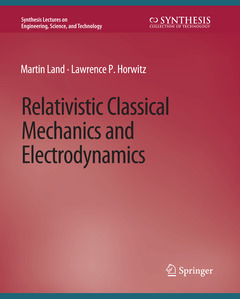Relativistic Classical Mechanics and Electrodynamics Synthesis Lectures on Engineering, Science, and Technology Series
Langue : Anglais
Auteurs : Land Martin, Horwitz Lawrence P.

This book presents classical relativistic mechanics and electrodynamics in the Feynman-Stueckelberg event-oriented framework formalized by Horwitz and Piron. The full apparatus of classical analytical mechanics is generalized to relativistic form by replacing Galilean covariance with manifest Lorentz covariance and introducing a coordinate-independent parameter ???? to play the role of Newton's universal and monotonically advancing time. Fundamental physics is described by the ????-evolution of a system point through an unconstrained 8D phase space, with mass a dynamical quantity conserved under particular interactions. Classical gauge invariance leads to an electrodynamics derived from five ????-dependent potentials described by 5D pre-Maxwell field equations. Events trace out worldlines as ???? advances monotonically, inducing pre-Maxwell fields by their motions, and moving under the influence of these fields. The dynamics are governed canonically by a scalar Hamiltonian that generates evolution of a 4D block universe defined at ???? to an infinitesimally close 4D block universe defined at ????+????????. This electrodynamics, and its extension to curved space and non-Abelian gauge symmetry, is well-posed and integrable, providing a clear resolution to grandfather paradoxes. Examples include classical Coulomb scattering, electrostatics, plane waves, radiation from a simple antenna, classical pair production, classical CPT, and dynamical solutions in weak field gravitation. This classical framework will be of interest to workers in quantum theory and general relativity, as well as those interested in the classical foundations of gauge theory.
Preface.- Symbols.- Conceptual Approaches to Spacetime.- Canonical Relativistic Mechanics.- Classical Electrodynamics.- Problems in Electrostatics and Electrodynamics.- Advanced Topics.- Authors' Biographies.
Martin Land was born in Brooklyn in 1953. He grew up in the New York City area, strongly influenced by his mother, a social worker who worked with Holocaust survivors, and his father, a second-generation engineer in small manufacturing businesses associated with the garment industry. In his school years he cleaned swimming pools and stables, worked as a carpenter on a construction site, and expedited orders in the garment center. In 1972, he entered Reed College in Portland, Oregon, where he received a Kroll Fellowship for original research which permitted him to devote an extra year to extensive study in the humanities along with his specialization in physics. After completing his BA in 1977, he returned to New York City where he received an M.S. in electrical engineering from Columbia University in 1979 as a member of the Eta Kappa Nu engineering honor society. He joined Bell Laboratories, developing specialized hardware for fiber optic communication with application in computer networks and video transmission. In 1982, he worked as a telecommunications engineer at a major Wall Street bank. Returning to theoretical physics at Hebrew University in Jerusalem, he worked with Eliezer Rabinovicci on supersymmetric quantum mechanics to receive a second M.S. in 1986. In 1985, he married Janet Baumgold, a feminist therapist and co-founder of the Counseling Center for Women. Following a year devoted to full-time fatherhood and another in compulsory national service, he began working toward a Ph.D. in high energy physics with Lawrence Horwitz at Tel Aviv University in 1988. He elaborated many aspects of the classical and quantum theories known as Stueckelberg-Horwitz-Piron (SHP) theory, producing a dissertation developing the SHP quantum field theory. Concurrently with his doctoral work, he was on the research faculty of the Computer Science Department at Hebrew University, developing specialized hardware for parallel computing. After submitting his dissertation in 1995, h
Date de parution : 12-2019
Ouvrage de 124 p.
19.1x23.5 cm
© 2024 LAVOISIER S.A.S.



